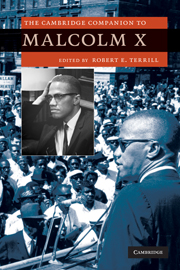Book contents
- Frontmatter
- Introduction
- 1 Malcolm X and Elijah Muhammad
- 2 Autobiography and identity: Malcolm X as author and hero
- 3 Bringing Malcolm X to Hollywood
- 4 Malcolm X and black masculinity in process
- 5 Womanizing Malcolm X
- 6 Malcolm X and the Black Arts Movement
- 7 Malcolm X and African American conservatism
- 8 Malcolm X and youth culture
- 9 Homo rhetoricus Afro-Americanus: Malcolm X and the “rhetorical ideal of life”
- 10 Judgment and critique in the rhetoric of Malcolm X
- 11 Nightmarish landscapes: geography and the dystopian writings of Malcolm X
- 12 Afrocentricity and Malcolm X
- 13 Malcolm X in global perspective
- 14 The legacy of Malcolm X
- Guide to further reading
- Index
6 - Malcolm X and the Black Arts Movement
Published online by Cambridge University Press: 28 May 2010
- Frontmatter
- Introduction
- 1 Malcolm X and Elijah Muhammad
- 2 Autobiography and identity: Malcolm X as author and hero
- 3 Bringing Malcolm X to Hollywood
- 4 Malcolm X and black masculinity in process
- 5 Womanizing Malcolm X
- 6 Malcolm X and the Black Arts Movement
- 7 Malcolm X and African American conservatism
- 8 Malcolm X and youth culture
- 9 Homo rhetoricus Afro-Americanus: Malcolm X and the “rhetorical ideal of life”
- 10 Judgment and critique in the rhetoric of Malcolm X
- 11 Nightmarish landscapes: geography and the dystopian writings of Malcolm X
- 12 Afrocentricity and Malcolm X
- 13 Malcolm X in global perspective
- 14 The legacy of Malcolm X
- Guide to further reading
- Index
Summary
Malcolm X exerted a profound and complex influence on the Black Arts Movement, the network of politically engaged African American artists and arts institutions during the 1960s and 1970s that poet, playwright, critic and activist Larry Neal termed the “aesthetic and spiritual sister of the Black Power concept.” Malcolm X served as inspiration, icon, model, polemicist, theorist, and adviser to the movement, especially in its formative years in the early and middle 1960s, despite the fact that he rarely discussed the arts in any great specificity in his public speeches - at least until his break from Elijah Muhammad and the Nation of Islam and the formation of the Organization of Afro-American Unity. For some Black Arts and Black Power activists, Malcolm X was a relatively distant, though commanding figure, often coming to them through the mass media, especially television and radio. However, for many others, especially in such early Black Arts Movement centers as New York, Philadelphia, Detroit, Boston, Chicago, and Oakland, he was a much more personal presence, a leader who always seemed to have time to talk to and take an interest in grassroots people. This engagement with the grassroots in turn strengthened Malcolm X's longstanding interest in African American culture, making it a central part of the program of the Organization of Afro-American Unity - which in turn further influenced radical black arts activists, such as Amiri Baraka, Gwendolyn Brooks, Etheridge Knight, Larry Neal, Sonia Sanchez, and Askia Touré and promoted the rise of cultural nationalism as a powerful, organized tendency within the Black Power movement.
- Type
- Chapter
- Information
- The Cambridge Companion to Malcolm X , pp. 78 - 89Publisher: Cambridge University PressPrint publication year: 2010



